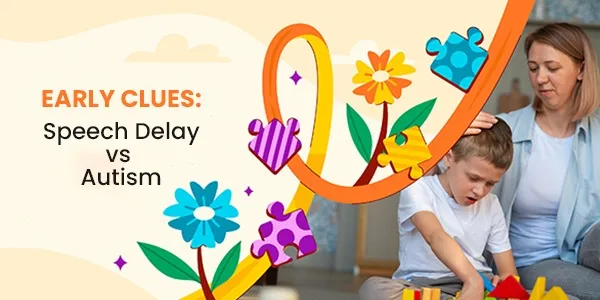Speech Delay vs Autism: How to Tell the Difference Early

Many parents begin noticing communication differences in their toddler around age 2. According to the CDC, about 1 in 6 children in the U.S. has a developmental delay, including speech issues. Additionally, studies show that the prevalence of isolated speech and language delays or disorders ranges between 5% and 12% (with a median of 6%) among children aged 2 to 5 years in the United States.
While some delays are a part of normal growth, others may point to deeper concerns like autism. Recognising the difference between a typical speech delay and early signs of autism is crucial — it ensures your child receives the right intervention at the right time.
Understanding How Speech Milestones Work
Children typically start speaking their first words between 12 to 18 months. By age 2, most toddlers begin combining two-word phrases. A speech delay means the child isn’t meeting these language milestones on time, but may still use gestures, eye contact, or facial expressions to communicate effectively with others.
Signs That May Suggest More Than a Speech Delay
Watch for these signs that could indicate something beyond just late talking, such as autism:
- Avoids or makes limited eye contact
- Does not respond to their name being called
- Shows little or no interest in social interaction
- Limited use of gestures like pointing, waving, or nodding
- Displays repetitive behaviors (e.g., hand-flapping, rocking)
- Has difficulty understanding or expressing emotions
- Prefers playing alone rather than with others
These signs often go beyond speech issues and may reflect challenges in social, emotional, and behavioral development—a common characteristic of autism spectrum disorder.
Differences in How Children Communicate Non-Verbally
Toddlers with speech delay often try to get their point across through gestures like pointing or pulling adults toward an object. In contrast, children with autism may show less interest in sharing attention or experiences with others, and might not use gestures to communicate at all. This lack of social communication is a key difference.
Behavioral Patterns to Watch Closely
Children with autism may display repetitive behaviors such as flapping hands, lining up toys, or fixating on specific topics. They might also struggle with changes in routine. Kids with only speech delay usually don’t exhibit these behaviors and are more open to engaging in imaginative play or new environments.
How Children React to the World Around Them?
Sensory sensitivities are more common in children with autism. They may be unusually sensitive to lights, sounds, or textures. Children with speech delays don’t typically react this way unless another developmental condition is present. These heightened responses can be early indicators worth exploring further.
Role of Play and Interaction in Development
Play is one of the best ways to gauge development. Kids with speech delay often enjoy interactive games like peek-a-boo or pretend play, while autistic children might prefer playing alone or focusing on specific parts of toys (like spinning wheels). These preferences can give important clues to parents and caregivers.
Getting a Clear Diagnosis Early Matters
Distinguishing between autism vs speech delay isn’t always straightforward. That’s why early screening and professional evaluation are so important. Pediatricians may recommend seeing a speech-language pathologist or developmental specialist to assess your child’s overall communication and behavior.
Why Seek Early Intervention for Autism or Developmental Delays?
Early intervention can significantly improve outcomes for children with developmental delays or autism. The earlier the support begins, the better the chances of improving communication, learning, and social skills. If you notice delays, don’t wait—getting answers sooner can help your child thrive.
Support That Understands Your Child’s Unique Needs
Whether your child is experiencing speech delays or showing early signs of a deeper concern, Mindsy is here to support you. We connect parents with qualified child psychologists, speech therapists, and behavioral experts who understand how to assess and address developmental needs with compassion and care.
At Mindsy, we offer more than just evaluations. Our platform provides access to therapies like occupational therapy, developmental assessments, and personalized progress plans, also if you are unsure where to start? Our team guides you from the first sign of concern to building a path toward your child’s growth — all from the comfort of your home.
FAQ’S
1. At what age should I be concerned if my child isn't talking yet?
Most children start speaking simple words by 12–18 months. If your child isn’t using words by age 2, or shows no signs of communication like gestures or eye contact, it’s a good idea to consult a child psychologist or speech therapist.
2. How can I tell if my child has autism or just a speech delay?
Speech delay usually affects only language. Autism may also involve social and behavioral issues like avoiding eye contact, not responding to their name, or repetitive behavior. A professional assessment is crucial to understand the root cause.
3. Can speech delay be an early sign of autism?
Yes, speech delay is often one of the early indicators of autism—but not always. What matters is how your child communicates overall and interacts socially. Early screening through platforms like Mindsy can help you get clarity.
4. When should I seek help for speech delay or autism signs?
If your child shows delayed speech, lack of social engagement, or developmental red flags by 18–24 months, it’s best to consult a professional. Early diagnosis and intervention can make a big difference in outcomes.
5. How does Mindsy help with speech delay and autism concerns?
Mindsy connects you with experienced child psychologists, speech therapists, and autism specialists. From early screening to personalised care plans, we’re here to support your child’s development every step of the way.
